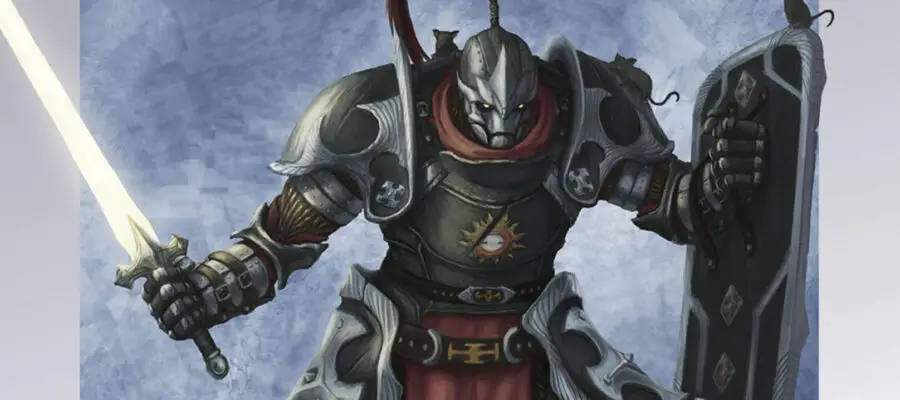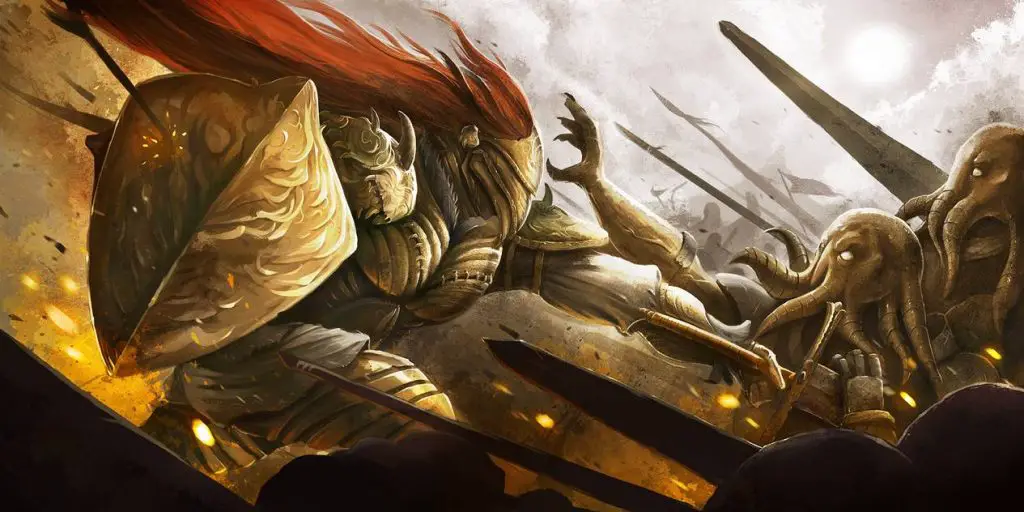Featured art “Commission – Warforged Paladin” by captdiablo. Creative Commons License.
This article contains affiliate links that add gold to our coffers.
Welcome to my crusade for the best feats for Paladins in D&D 5e; I’ll reveal the premium feats to empower the divine warrior you’re destined to become. Feats are powerful customizations when coupled wisely with class abilities. Some feats are better than others, so I’ll direct you to Paladin feats that are worth your character’s time to learn.
Feats are spread out through several books, making it difficult to settle on 5e’s best Paladin feats. I’m providing a noble service by summarizing the best feats, so you can avoid feats that would generally be duds for your Paladin. My feat recommendations come from officially published sources, such as the PHB, TCoE, XGtE, etc.
How to Select Useful Feats for Your Paladin
The Paladin class is MAD: Multiple Ability (Score) Dependent. This means Paladins want 2-3 ability scores to be relatively high to take full advantage of their class abilities. Paladins typically want high Charisma and Strength while still investing a bit in Constitution. Strength is sometimes switched to focus on Dexterity. This dependence on ability scores will make it difficult to justify taking a feat if boosting a stat by two could be better. Feats that also boost stats will be extra important to a Paladin.
Paladins are often free to use their bonus actions and reactions, so feats that use those won’t crowd the action economy. Smite spells use bonus actions, but experience has shown me that most Paladins will use Divine Smite instead of casting smite spells.
It’s common for Paladins to multiclass. My recommendations focus on the Paladin class, not the many multiclass combinations available. I’d welcome suggestions for overlooked feats that become worthwhile with a particular multiclass concept.
With the premise out of the way, here are my top ten feats for Paladins in D&D 5e!
Top 10 Paladin Feats of D&D 5e
Unlike other classes I’ve provided feats guides for, I narrowed down the Paladin to a list of ten feats that are nearly guaranteed to be useful. While other feats may suit your character, these ten feats should be strongly considered for an effective Paladin build. Some feats become more effective when coupled with others, so watch for synergies.
While my recommendations will help you identify feats that suit a typical Paladin, don’t be afraid to choose other feats to make your Paladin unique. As long as you know what you’re getting into, you can have fun with many feat options. Having said that, here are my top ten Paladin feats for D&D 5e:
#10 Shield Master
Shield Master greatly enhances the effectiveness of a “sword and board” Paladin. Your training with this feat allows you to become like a Rogue with your ability to dodge damage from Fireballs partially or completely. You’ll also gain what is essentially a half-cover bonus to a Dexterity saving throw that targets you, though I’m not sure how often you’ll be targeted in this way.
You really want to embrace the bonus action to shove a creature if you use the Attack action on your turn. Knocking a creature prone will give you and allies advantage to attack it until it stands up using half its movement. Once up, it’ll be difficult for the enemy to escape with their movement mostly expended to stand. Please pay attention to the initiative order so you can shove a creature who will suffer the attacks of your allies before its turn arrives. Be careful not to use this shove if you have allies relying on ranged attacks focused on your same target; ranged attacks have disadvantage to hit prone creatures.
Caveat for Shield Master
Now that I’ve pointed out how the Shove bonus action is great for your subsequent attacks, I need to pump the brakes there. While that’s how every DM I’ve ever played with has ruled the Shield Master feat to function, it’s technically not RAW, according to Jeremy Crawford. The Shield Master feat requires the Attack action to be resolved (all of the attacks) before a bonus action, reaction, or other ability can be used (unless specified directly).
Sure, you can move between attacks, but you can’t use Shield Master’s Shove by RAW. For example, a Monk with Extra Attack would be required to resolve all of the attacks that result from the Attack action before the Monk could use a bonus action to make Martial Arts attacks. This is because the Martial Arts attacks with the bonus action are predicated on the Attack action, not an attack. A character with the Shield Master feat wouldn’t be able to use the bonus action Shove until after all attacks with the Attack action are resolved because Shield Master’s bonus action is predicated on the Attack action, not an attack.
While I understand the ruling from Jeremy Crawford, I’ve never seen Shield Master applied this way. I’m not too fond of this ruling, but it’s a weakness in Shield Master’s design more than a weakness in the game’s design. If your DM rules this by RAW, Shield Master might drop to #6 or #7 on this list.
#9 Elven Accuracy (Elves)
Grab your sword and fishing pole because it’s time to fish for crits. Many Paladin builds involve fishing for critical hits so Divine Smites can be unleashed with true heaven’s fury. If you’ve chosen an Elven race, this feat should be strongly considered.
However, don’t get too excited; you’ll still need ways to gain advantage on your melee weapon attacks. Look at your Paladin subclass, spells, and the abilities of allies to see if you’ll be securing advantage on melee weapon attacks often. If it’s going to be tricky to do so, consider synergistic feats on my top ten list to see which ones can help gain advantage, like Shield Master or Mounted Combatant.
Elven Accuracy will also allow you to boost your Dexterity or a mental stat. I recommend building your Paladin to use Strength over Dexterity, but I know Dexterity can be viable. The more common choice will be to increase Charisma by one.
#8 Mounted Combatant
While I believe Mounted Combatant is a good feat for any character focusing on mounted combat, the Paladin excels with its Find Steed and Find Greater Steed spells. You can reliably summon a faithful mount with the intelligence to act on its if you wish. Mounted Combatant also pairs well with other useful feats as it doesn’t crowd the action economy or demand a particular type of build. The feat’s build-agnostic nature is a massive selling point to choose it.
Riding a mount will enhance your mobility dramatically. It would be best if you kept your mount alive, and Mounted Combatant affords you tools to protect your pet. The feat also gives you advantage on unmounted creatures who are smaller than your mount. Gaining advantage is huge for a Paladin. More chances to land critical hits will lead to epic Divine Smites. Paired with the Elven Accuracy, you’ll hardly ever miss an attack, and critical hits will become more frequent. This feat won’t be as helpful against creatures who are larger than your mount, so this feat is devalued in a campaign where you’ll often fight enormous enemies.
I highly recommend my article about movement and positioning tactics in D&D 5e. You’ll see why mounts can change the way you play. Opal also has an article about how to roleplay, raise, and acquire mountable creatures, which I recommend wholeheartedly. She also explains the rules for using mounts in 5e if you need to brush up on their mechanical benefits and requirements.
#7 Great Weapon Master
Gamblers will love this feat. You might miss due to the accuracy penalty, but your hits can deal ten extra damage. This feat is better for Paladin subclasses that possess abilities for gaining advantage on melee weapon attacks. Paladins of Vengeance can use their Vow of Enmity option for Channel Divinity to gain advantage reliably.
You’ll need to omit your option to use a shield, but you can couple this feat with the Polearm Master feat. Wielding a halberd will allow you to make two attacks with Extra Attack and the third attack as a bonus action with the halberd pummel. Each of these attacks will be candidates for Great Weapon Master to enhance their damage. You can potentially increase your damage per round by thirty. The negative synergy is that you will already have an option for your bonus action attack, so the Great Weapon Master’s bonus action attack ability is nearly negated. I say ‘nearly negated’ because the benefit would be to attack with 1d10 instead of 1d4 damage.
While the damage is impressive, you will also miss some of your attacks if you attack creatures with high ACs while taking the -5 penalty to your attacks. For this reason, you will likely not take the gamble on certain foes, meaning this feat will not benefit you against them. You’ll also need a high Strength score to offset the optional -5 to attack rolls, though many players multiclass with Hexblade Warlock so they can focus on Charisma for developing their lethality.
#6 Fey Touched
Though it’s not a feat most Paladins would select, Fey Touched can be a valuable Charisma stat boost with added magical utility. You can immediately benefit from the ability score boost by increasing your Charisma by one. Misty Step is a clutch spell that often comes in handy. Cast it to quickly maneuver to your intended target while retaining your action for attacking. Misty Step is also handy for escaping grapples, clearing tar and lava, or moving through portcullises.
You gain an additional spell of divination or enchantment. I recommend choosing Hunter’s Mark or Hex. You can cast either with your bonus action to enhance your damage output against a target creature. This works especially well if you’re not utilizing your bonus action already. Other unique options include Tasha’s Hideous Laughter and Charm Person.
This feat is excellent for Paladins who want more spell options without multiclassing. That accompanying stat boost is important, too, without which this feat may not have made the top ten. Remember, Oath of Vengeance and Oath of the Ancients Paladins already gain Misty Step as Oath Spells, so you can pass on this feat if you have chosen either of those subclasses.
#5 Resilient
You can boost your Constitution and gain proficiency with Constitution saving throws. This proficiency will help you maintain concentration on spells, especially when you pair it with the Charisma bonus your Paladin aura will add to your saving throws. Good luck to any fool who tries to break your concentration!
You can choose to gain other saving throw proficiencies, but I recommend Constitution. It’s that simple!
#4 Inspiring Leader
Grant yourself and allies temporary hitpoints when you rest. The temporary hitpoints will scale as you level up and increase your Charisma. This ability is archetypical of the Paladin as a righteous leader. It’s a great way to be a team player.
If your party complains that you never heal them in battle, you can pre-heal them with temporary hitpoints. Preventing damage is better than healing damage. Your party may have a few NPCs to travel with, and your speech can instill them with temporary hitpoints as long as they’re present and able to understand you.
This feat gets the most value in groups where each party member is likely to take damage in a given adventuring day. Receiving temporary hitpoints is effectively moot if the recipient isn’t attacked. Be wise about whether your party can benefit from this feat enough to warrant a feat slot for you.
Caveat to Inspiring Leader
Abilities that grant temporary hitpoints are becoming commonplace in D&D 5e as additional books are published. Pay attention to your party composition and its skills. If you already have characters who can regularly gift temporary hitpoints to the party, you can consider another feat in place of Inspiring Leader.
#3 Heavy Armor Master
You can boost your Strength by one. The stat boost is a big deal for a Paladin. Playing as a Variant Human with a feat at level one makes this feat more attractive. There are fewer magical items in the early levels of a campaign, making this feat’s damage reduction nearly guaranteed to be helpful. While suffering damage from non-magical weapons, your effective hitpoints go up more than the Tough feat would grant you. Reducing damage from four attacks is like having twelve more hitpoints. There are few ways to reduce incoming damage in D&D 5e, so Heavy Armor Master sticks out as a unique, effective way to improve your survivability.
This feat is powerful if you have an ally who can grant temporary hitpoints continuously, like a Twilight Cleric. If supportive allies are scarce, you can cast Heroism on yourself to give you a buffer of temporary hitpoints and damage reduction from your armor each round. For the sake of setting expectations, remember that your DM might stop targeting you if you’re too durable. Monsters aren’t always dumb, so they’ll switch targets if they catch on to your durability.
Caveats for Heavy Armor Master
The defensive value of reducing incoming non-magical weapon damage (slashing, bludgeoning, piercing) is controversial. Some would say that many monsters have natural or forged weapons that count as magical. Ask your DM for their interpretation of monster weapons to see what constitutes being magical. If your DM treats magical monsters’ natural weapons as magical, you might want to pass on this feat.
#2 Polearm Master
Enhance your reach weapons by attacking with your pommel as a bonus action. This small bonus action attack qualifies for damage bonuses from Divine Smite and feats on this list. You’ll also be able to attack as a reaction when an opponent enters your weapon’s reach, coupling very well with the Sentinel feat.
Choosing this feat specifically for more smiting can come back to bite you unless you’re playing in a game where you typically have one or two fights before you take a long rest. Smiting a creature three times instead of two times on your turn can help you focus down that target, but that really won’t matter if your Fighter ally would make several regular attacks that would put down the enemy anyway with no resources expended. Keep that in mind, and you’ll do fine.
This feat’s value goes up if you take the Sentinel feat since you can stop a foe in its tracks while you’re still outside its melee attack range.
#1 Sentinel
The biggest selling point with the powerful Sentinel feat is that it is compatible with the other worthy feats in this Paladin feats list. Whether you’re using polearms, shields, or heavy weapons, you can benefit from Sentinel and synergize with your other feats. Sentinel is also a worthy feat if you want to be a Dex-based Paladin.
You’ll weaponize your reaction by securing your opportunity attacks or using your ally-defending attack. Sentinel won’t allow Disengage actions to free enemies from your opportunity attack option. You can also keep enemies close by reducing their movement speed to zero in these instances. The more attacks you have as a Paladin, the better. Each successful attack can use your Divine Smite, assuming you have spell slots to burn. Remember, don’t use all your spell slots to smite an enemy that your allies can put down without expending resources.
Enemies will encounter trouble as you react to attack them when they attack your nearby ally. If you use a reach weapon with Polearm Master, you can stop an enemy before they get within a five-foot-melee range. You might completely waste an enemy’s turn when doing this if the enemy has no other options to harm you.
You might choose other feats before this feat in your character build, but Sentinel should almost certainly be paired as a second feat.
Honorable Mention: Bountiful Luck (Halflings)
Your little Halfling can be the heart of the party. The luck inherited by your race spills over to your allies, allowing them to reroll d20s that roll ones. It will only cost your reaction to do so. You’ll need to be near your allies to qualify, but your Paladin auras already incentivize you to keep your allies adjacent.
Rolling a natural one can be devastating. Bountiful Luck allows you to continuously aid your allies who roll them. Higher levels of play will mean the party’s Fighter, for example, could be making many attacks in a round. More attacks means more chances to roll ones. Stay shoulder to shoulder with your martial buddies so you can use your reaction to reroll their ones.
Playing a Halfling will mean you can’t use heavy weapons, so that some other feat options won’t be available to you due to their lack of benefit to a small creature like you. This opens you up to creativity with other feats! Yep, I’m taking the optimist view. Several feats on this list will work just as well for a Halfling as any other race.
Alternative Paladin Feats
These feats could work for a Paladin who wants to get creative or achieve something specific. They didn’t make the top ten, but that doesn’t mean they won’t work for your character concept!
Poisoner: You can smite, but you can also smite with poison! This may work well for a Paladin who embraces underhanded tactics.
Slasher/Crusher: Great for enhancing a specialized weapon type. Slasher can slow an enemy once per turn, and Crusher can bash them around to mess with positioning. Both come with a stat boost! Pairing Slasher with mobile can be effective for kiting strategies.
Lucky: They’re dull, but they can also help a character out if you want feats that give you passive abilities that are easy to remember and use.
Telepathic: Conquest Paladins can enjoy reading thoughts and casting thoughts of judgement into the minds of heretics and weaklings. It boosts Charisma, too. It’s a fantastic roleplaying opportunity. None shall escape scrutiny!
Conclusion
If you’ve learned nothing else from this article, I hope you’ve learned that Paladins can benefit from many combative styles and feat specialties. While my recommendations are grounded in experience, game mechanics, and metagame knowledge, I recognize the subjective nature of feat recommendations. I attempted to explain assumptions and subjective points, but I welcome feedback on my blind spots. I’m confident that you’ve learned how to choose Paladin feats wisely by exploring my summary.
Tell me, which feats have I been fair or unfair to? In the comments section below, cast Message to communicate if you emphatically agree with my recommendations or passionately disagree. I’ve been wrong before, so you should consider it a challenge to find any mistakes I’ve made in my analysis! Thank you again for reading. I hope you’ll share this article with your friends to get a discussion started.
Oh, it seems you possess a high Passive Perception score. Before you go, take these secret passageways to discover more content about feats and character concepts!
- Ratings for Each Feat of 5e Dungeons and Dragons
- Burly Feats for Barbarians
- Clever Feats for Rogues
- Worthy Feats for Clerics
- Smart Feats for Wizards
- Wise Feats for Monks




